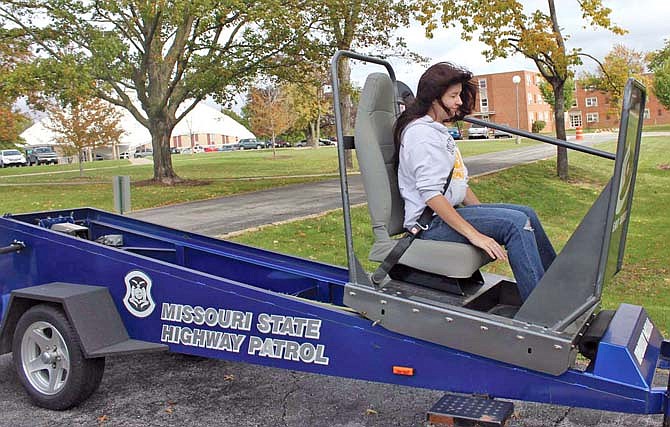Three car accident survivors took a packed William Woods University library auditorium on an emotionally wild ride Tuesday in the hopes that others would drive more defensively behind the wheel.
They were there as part of ThinkFirst Missouri, an education and advocacy group dedicated to preventing traumatic injuries and promoting vehicular safety. The audience heard from Penny Lorenz, Chad Burton and Keller Colley as each shared their experiences as unbuckled or impaired drivers and passengers whose lives were changed permanently by injury.
"We go all over the state to promote "use your mind to protect your body,'" Lorenz said.
Lorenz started the presentation with a slide show on traumatic brain injury, spine injuries and statistics on car accidents and injuries. She explained that injuries are the leading cause of death for people aged 1-44 in America, with the group at highest risk between mid-teens and 20s.
The highest risk factors for serious car accidents are speeding and drowsy or distracted driving. Not wearing a seat belt significantly increases your chance of traumatic injury to the brain or spine.
Lorenz said the combination of airbags and no seat belt also increased your risk of spine damage, and most accidents involving texting while driving occurred while the driver was distracted for only three to five seconds.
"Not only are you risking your own life, but you're risking the lives of other people with you or sharing the roads. You're not going to like it if you do this to yourself, but it's a whole other life sentence if you take someone else's life."
Lorenz also told her personal story of how, as a 17-year-old in Harrisburg, she became paraplegic after her friend crashed her car while Lorenz was not wearing a seat belt.
"We were about 30 seconds from my driveway and I was yelling "slow down, you're taking those turns way too fast.' She yelled back over the music "I'm not going that fast, watch this,' and then we lost control. I went through the windshield the second time the car rolled."
Lorenz' speech gave way to fellow survivor Chad Burton. Burton was a wrestling standout at Rock Bridge High School in Columbia when the van in which he was driving two teammates got into a wreck on Rock Quarry Road in 1992.
His friend in the back seat sustained injuries but went on to recover, while his friend in the front seat - who was wearing a seat belt - emerged unscathed.
"I believe he saved two lives that night, because he was okay and could run and get help," Burton said. "They had to cut me out of the car, so if he hadn't been able to do that ... they wouldn't have saved me."
Burton spent the next five weeks in a coma. Afterward, he spent nearly a year in physical rehab and had to return to school in a wheelchair while wearing a bicycle helmet - doctors were forced to remove part of his skull for several months to give his brain room to swell.
He lives with partial paralysis in the left side of his body and had to focus on rehabilitating his short-term memory.
In spite of the serious nature of his accident, Burton punctuated his talk with charisma and humor. He elicited laughs from his audience when joking about being embarrassed by having his mother tie his shoes as a high schooler before he learned to do so with one hand - a feat he demonstrated.
Keller Colley then closed with his story. As a freshman attending college in Moberly, two of his fraternity brothers were killed in the alcohol-related crash, while Colley and one other man were seriously injured after being thrown from a truck.
Colley also spent time in a coma and damaged his front-left temporal lobe, affecting his short-term memory and motor functions.
He spoke candidly on his struggles with substance abuse following his first accident, which led to two more roll-over accidents. He showed the largely college-aged audience video of his time spent in recovery, and followed with a stern warning on the importance of driving safely.
"When we're young we like to think we're invincible," he said. "You can take some pretty hard hits, but there's no need to do it. It's going to hurt you if you don't have your seat belt on."
Sgt. Paul Reinsch with Troop F of the Missouri State Highway Patrol was also on hand after the lecture to give students a shot at trying out the Seat Belt Convincer, a device that simulates the force of a head-on collision at 5 mph.
WWU sophomore Jenny Parr said both the session - and the simulator - were impactful.
"It makes you think," Parr said. "I know I probably won't do it all the time, but next time I get in a car I'll be thinking about the presentation."

